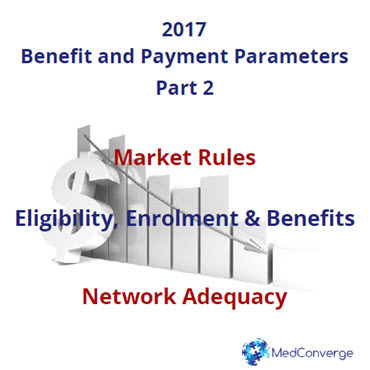In continuation of our previous article on the Benefit and Payment Parameters for 2017, given below are further highlights of some of the policies in the final rule.
Market Rules
Student Health Insurance Plans
Risk pool must be based on bona fide school related classification and not on health status if issuers of student health insurance plans wish to establish one or more separate risk pools for each individual college or university. Rate adjustments within a risk pool have to be actuarially justified and the premium rates for each pool have to reflect the claims experience of the individuals who comprise the pool. The requirement for student health insurance plans offering coverage within specific metal levels has been removed. Student health insurance plans are now required to offer at least 60% actuarial value.
Rate Review
Irrespective of whether issuers propose rate increases or decreases, or no change in the rates; they are required to submit URRT (unified rate review template) for all risk pool products. This is valid for these products offered in the individual and small market groups. However, student health plans are excluded from this group.
Eligibility, Enrollment, and Benefits
Annual Open Enrollment Period
In order to provide continuity for the short term and sufficient time for all entities, including issuers and Exchanges, involved in the annual open enrollment period process; the 2017 and 2018 benefit year open enrollment period for the individual market Marketplaces will begin on November 1, 2016 and run through January 31 of the benefit year. Similarly, the open enrollment for benefit 2019 and later will begin on November 1 and run through December 15 of the year preceding the benefit year.
Federal Platform used by State-based Marketplaces
Collecting user fees to cover Federal costs and retaining primary responsibility for consumer assistance and outreach, plan management functions, ongoing oversight and program integrity, and for ensuring that all Marketplace requirements are met, the State-based Marketplaces on the Federal platform (SBM-FPs), will rely on the Federal platform for eligibility determinations and enrollment processing activities, and associated Federal platform services. The requirements for SBM-FPs enforce certain QHP and QHP issuer requirements that are no less strict than the requirements applied by HHS to QHPs and QHP issuers in the FFMs are also being finalized. Similarly, the authority of HHS to suppress plans on HealthCare.gov in appropriate circumstances is also being finalized.
Standardized Options
The proposal to designate plans with certain standardized cost-sharing structures as “standardized options,” is being finalized. This will simplify the shopping experience for consumers on the individual market Federally-facilitated Marketplaces and give consumers the opportunity to more easily compare plans offered by different issuers within a metal level. 6 specific recommended designs (1 silver, which would be coupled with 3 silver cost-sharing reduction variations, 1 bronze and 1 gold) have been developed and consumer testing is being carried out. However, it is optional for issuers to offer standardized options.
Network Adequacy (Continuity of Care)
Two provisions regarding continuity of care applicable to QHPs on FFMs have been finalized. First, written notice of discontinuation of a provider has to be issued by the issuer to all enrolls who are patients seen on a regular basis by the provider or receive primary care from the provider, 30 days prior to the effective date of the change or otherwise as soon as practicable. Second, enrolls in active treatment be allowed to continue treatment until the treatment is complete or for 90 days (whichever is shorter) at in-network cost-sharing rates, in cases a provider is terminated without cause.
Network Adequacy (Cost Sharing)
Aimed at limiting ‘surprise bills’ to the consumer, this provision beginning 2018, requires out-of-network services provided at an in-network facility by an ancillary provider to an enroll must be counted by the issuer towards the enrolee’s annual limitation on cost sharing. This provision does not come into effect if a written notice is provided by the issuer to the enroll that the enroll may incur additional costs. This notice has to be provided to the enroll 48 hours prior to the service that an out-of-network ancillary provider may be providing or by the longer of when the issuer would typically respond to a prior authorization request timely submitted.
We will bring you further highlights of some of the policies in the final rule in Benefit and Payment Parameters for 2017 – Part 3.








